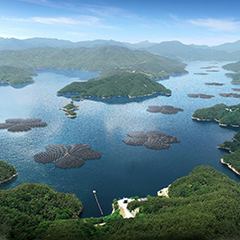The 41 MW floating solar plant will be installed at the Hapcheon Dam in the south of the country in what will become the largest such PV construction located at a dam anywhere in the world.
[Seoul, South Korea, November 13, 2020] Q CELLS will construct a 41 MW floating PV power plant, which once complete will become the world’s largest floating PV constructed on a dam, as well as the largest floating PV plant permitted in Korea. Q CELLS won the rights to develop this floating PV project in August from K-water (the Korea Water Resources Institute), and received final permission to begin construction on November 4. Q CELLS will begin construction by the end of this year.
The floating PV plant is a combination of onshore solar technology and floating structure technology. This style of PV plant is growing in popularity in mountainous and densely populated regions because it covers only the water’s surface, which is an idle space, and has the advantage of up to 10% higher power generation compared to onshore PV power plant thanks to less shadowing influence and the cooling effect of the water.
The Hapcheon Dam floating PV power plant will produce enough solar electricity to meet the annual power needs of 60,000 people, which is more than the actual 44,434 population of the Hapcheon-gun in which the plant will be sited. Q CELLS will construct this floating PV power plant with a design inspired by the plum blossom, the symbolic flower of Hapcheon-gun.
Clean power, ecologically delivered
The environmental stability of the Hapcheon Dam floating solar power plant has also been verified. According to a result of monitoring tests conducted on four separate occasions at the Hapcheon Lake Solar Power Empirical Study Complex by the Korea Environment Institute (“KEI”), there was scientific consensus that the PV power plant will have no negative environmental impact. The KEI conducted research on water quality and aquatic ecology, revealing that there was no significant difference between the water area covered by the power plant and the uncovered water area.





























